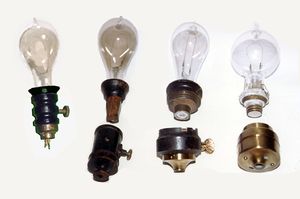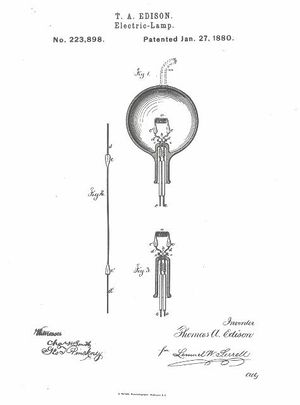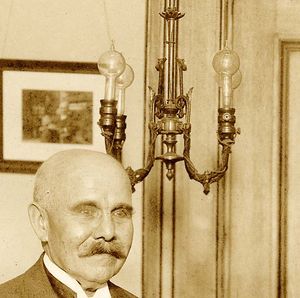Early Light Bulbs: Difference between revisions
m (Text replace - "[[Category:Power, energy & industry application|" to "[[Category:Power, energy & industry applications|") |
m (Text replace - "[[Category:Light sources" to "[[Category:Lasers, lighting & electrooptics") |
||
| (One intermediate revision by one other user not shown) | |||
| Line 1: | Line 1: | ||
== Early Light Bulbs<br> == | == Early Light Bulbs<br> == | ||
[[Image:Edison Light Bulb Patent 2154.jpg|thumb| | [[Image:Edison Light Bulb Patent 2154.jpg|thumb|left]] | ||
The warm glow of the light bulb is the part of today’s [[Electric Lighting|electric lighting system]] that we know best. [[Thomas Alva Edison|Thomas Edison is]] often said to have [[Edison's Incandescent Lamp|invented the light bulb]], but his bulb was not a completely original idea. In fact, the principle of electric incandescent lighting (making a wire glow by sending electricity through) had been around since at least 1802, when Englishman [[Sir Humphry Davy|Humphry Davy]] demonstrated it. In 1840 another English inventor, Warren De la Rue, used a platinum filament inside a glass bulb, an idea Edison would later try but reject. The air inside the De la Rue bulb was pumped out, because inventors understood that if the filament was not in a vacuum, the oxygen in the air would cause a chemical reaction with the filament and destroy it. One problem with doing things this way, however, was that it was difficult to seal the glass around the wires that supply electricity to the filament. Finding a good material for the filament and keeping the air out were major problems Edison eventually overcame. | The warm glow of the light bulb is the part of today’s [[Electric Lighting|electric lighting system]] that we know best. [[Thomas Alva Edison|Thomas Edison is]] often said to have [[Edison's Incandescent Lamp|invented the light bulb]], but his bulb was not a completely original idea. In fact, the principle of electric incandescent lighting (making a wire glow by sending electricity through) had been around since at least 1802, when Englishman [[Sir Humphry Davy|Humphry Davy]] demonstrated it. In 1840 another English inventor, Warren De la Rue, used a platinum filament inside a glass bulb, an idea Edison would later try but reject. The air inside the De la Rue bulb was pumped out, because inventors understood that if the filament was not in a vacuum, the oxygen in the air would cause a chemical reaction with the filament and destroy it. One problem with doing things this way, however, was that it was difficult to seal the glass around the wires that supply electricity to the filament. Finding a good material for the filament and keeping the air out were major problems Edison eventually overcame. | ||
| Line 8: | Line 8: | ||
De la Rue’s platinum bulb worked, but platinum was far too expensive to use in commercial light bulbs. Thomas Edison, after investigating many different filament materials, settled on carbon filament in 1879. At about the same time, an English inventor named Joseph Swan came up with almost the same idea, leading to claims that it was he who really invented the light bulb. Clearly, no single inventor deserves sole credit for the light bulb. What was unique about Edison’s work was that he carried the idea from laboratory to commercialization, taking into consideration not only technical problems, but also issues like economics and the production of bulbs. | De la Rue’s platinum bulb worked, but platinum was far too expensive to use in commercial light bulbs. Thomas Edison, after investigating many different filament materials, settled on carbon filament in 1879. At about the same time, an English inventor named Joseph Swan came up with almost the same idea, leading to claims that it was he who really invented the light bulb. Clearly, no single inventor deserves sole credit for the light bulb. What was unique about Edison’s work was that he carried the idea from laboratory to commercialization, taking into consideration not only technical problems, but also issues like economics and the production of bulbs. | ||
[[File:1880EDISON1881LampsSOCKETSrwLIPACKowner.jpg|thumb|left|(400px)|'''Photo credit: Richard Warren Lipack / Wikimedia Commons.''' The evolution of Edison's incandescent electric light bulb and socket - 1880-1881. Left to right: First form "1880 Wire Terminal Base" socket and bulb as used on the S.S. Columbia - first commercial installation of Edison electric lighting system; Second form "1880 Wire Terminal Base" socket and bulb; "1880 Original Screw Base" socket and bulb and the "1881 Improved Screw Base" socket and light bulb.]] | |||
[[File:1880EDISONChandelierFrancisJehlrwLIPACKowner.jpg|thumb|right|(400px)|'''Photo credit: Richard Warren Lipack / Wikimedia Commons.''' Detail of original Edison chandelier with first form "1880 Wire Terminal Base" sockets and incandescent lamps behind "Edison Pioneer" and 'Edisonian' author Francis Jehl.]] | |||
Edison’s carbon filament gave his lighting system an inexpensive bulb, and also the carbon filament worked well at about 110 volts, which Edison considered an economical and safe voltage for the distribution of electricity. In the original Edison and Swan bulbs, the filament was made by burning a cotton thread until all that was left was black carbon. However, the resulting filament was fragile, so Edison later substituted a burned bamboo filament (another idea that had been tried earlier). Combined with the use of an improved vacuum pump to clear more air out of the bulbs, this gave his lamps a maximum lifetime of approximately 1200 hours, versus only 14 or so for the cotton filament bulb. | Edison’s carbon filament gave his lighting system an inexpensive bulb, and also the carbon filament worked well at about 110 volts, which Edison considered an economical and safe voltage for the distribution of electricity. In the original Edison and Swan bulbs, the filament was made by burning a cotton thread until all that was left was black carbon. However, the resulting filament was fragile, so Edison later substituted a burned bamboo filament (another idea that had been tried earlier). Combined with the use of an improved vacuum pump to clear more air out of the bulbs, this gave his lamps a maximum lifetime of approximately 1200 hours, versus only 14 or so for the cotton filament bulb. | ||
[[Category:Power, energy & industry applications|Light bulbs]] [[Category:Lasers, lighting & electrooptics|Light bulbs]] [[Category: | [[Category:Power, energy & industry applications|Light bulbs]] [[Category:Lasers, lighting & electrooptics|Light bulbs]] [[Category:Lasers, lighting & electrooptics|Light bulbs]] [[Category:Electric lighting|Light bulbs]] [[Category:News|Light bulbs]] | ||
Revision as of 14:39, 13 May 2014
Early Light Bulbs
The warm glow of the light bulb is the part of today’s electric lighting system that we know best. Thomas Edison is often said to have invented the light bulb, but his bulb was not a completely original idea. In fact, the principle of electric incandescent lighting (making a wire glow by sending electricity through) had been around since at least 1802, when Englishman Humphry Davy demonstrated it. In 1840 another English inventor, Warren De la Rue, used a platinum filament inside a glass bulb, an idea Edison would later try but reject. The air inside the De la Rue bulb was pumped out, because inventors understood that if the filament was not in a vacuum, the oxygen in the air would cause a chemical reaction with the filament and destroy it. One problem with doing things this way, however, was that it was difficult to seal the glass around the wires that supply electricity to the filament. Finding a good material for the filament and keeping the air out were major problems Edison eventually overcame.
De la Rue’s platinum bulb worked, but platinum was far too expensive to use in commercial light bulbs. Thomas Edison, after investigating many different filament materials, settled on carbon filament in 1879. At about the same time, an English inventor named Joseph Swan came up with almost the same idea, leading to claims that it was he who really invented the light bulb. Clearly, no single inventor deserves sole credit for the light bulb. What was unique about Edison’s work was that he carried the idea from laboratory to commercialization, taking into consideration not only technical problems, but also issues like economics and the production of bulbs.

Edison’s carbon filament gave his lighting system an inexpensive bulb, and also the carbon filament worked well at about 110 volts, which Edison considered an economical and safe voltage for the distribution of electricity. In the original Edison and Swan bulbs, the filament was made by burning a cotton thread until all that was left was black carbon. However, the resulting filament was fragile, so Edison later substituted a burned bamboo filament (another idea that had been tried earlier). Combined with the use of an improved vacuum pump to clear more air out of the bulbs, this gave his lamps a maximum lifetime of approximately 1200 hours, versus only 14 or so for the cotton filament bulb.

